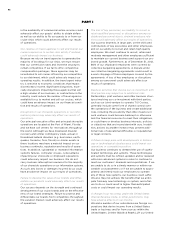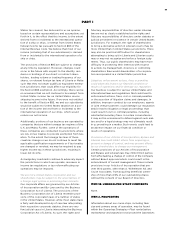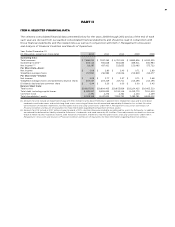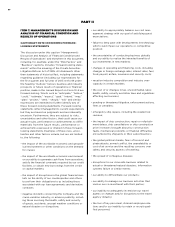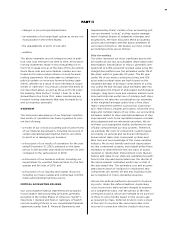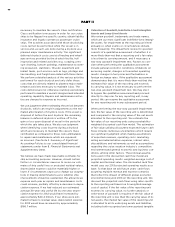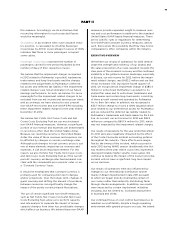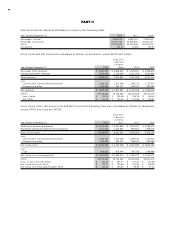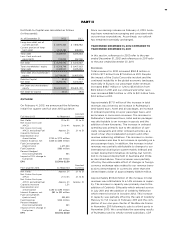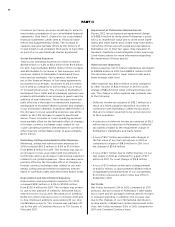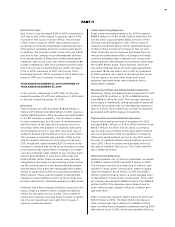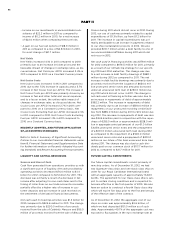Royal Caribbean Cruise Lines 2012 Annual Report Download - page 46
Download and view the complete annual report
Please find page 46 of the 2012 Royal Caribbean Cruise Lines annual report below. You can navigate through the pages in the report by either clicking on the pages listed below, or by using the keyword search tool below to find specific information within the annual report.
42
PART II
assumptions and the expectations regarding future
capacity growth for the brand.
Based on our updated cash flow projections, we
determined the implied fair value of goodwill was
$145.5 million and recognized an impairment charge
of $319.2 million. Similarly, we determined that the
fair value of Pullmantur’s trademarks and trade names
no longer exceeded their carrying value. Accordingly,
we recognized an impairment charge of approximately
$17.4 million to write down trademarks and trade
names to their fair value of $204.9 million.
As part of step two of our goodwill impairment analy-
sis, we identified that the estimated fair values of
certain long-lived assets, consisting of three aircraft
owned and operated by Pullmantur Air, were less
than their carrying values. As a result, we proceeded
to our long-lived asset impairment test. Pullmantur’s
strategy to further diversify its passenger sourcing
and reduce its reliance on the Spanish market has
led us to reduce the expected years in which we will
use these aircraft when performing the undiscounted
cash flow test. The undiscounted cash flows for
Pullmantur’s aircraft were determined to be less than
their carrying value and an impairment charge of
$48.9 million was required.
The combined impairment charge of $385.4 million
related to Pullmantur’s goodwill, trademarks and
trade names and aircraft was recognized in earnings
during the quarter ended December 31, 2012 and is
reported within Impairment of Pullmantur related
assets within our consolidated statements of com-
prehensive income (loss).
The factors influencing the Spanish economy and
Pullmantur’s operating cash flows discussed above
also affect the recoverability of Pullmantur’s deferred
tax assets. During the fourth quarter of 2012, we
updated our deferred tax asset recoverability analysis
for projections included within the goodwill valuation
model discussed above. These projections, including
the impact of recently enacted laws regarding net
operating loss utilization, and the review of our tax
planning strategies show that it is no longer more-
likely-than-not that we will recover the deferred tax
assets prior to their expiration. As such, we have
determined that a 100% valuation allowance of our
deferred tax assets was required resulting in a deferred
income tax expense of $33.7 million. In addition,
Pullmantur has a deferred tax liability that was
recorded at the time of acquisition. This liability rep-
resents the tax effect of the basis difference between
the tax and book values of the trademarks and trade
names that were acquired at the time of the acquisi-
tion. Due to the impairment charge related to these
intangible assets, we reduced the deferred tax liability
by $5.2 million. The net $28.5 million impact of these
adjustments was recognized in earnings during the
fourth quarter of 2012 and is reported within Other
(expense) income in our statements of comprehensive
income (loss).
If the Spanish economy weakens further or recovers
more slowly than contemplated or if the economies
of other markets (e.g. France, Brazil, Latin America)
perform worse than contemplated in our discounted
cash flow model, or if there are material changes to
our projected future cash flows used in the impair-
ment analyses, especially in Net Yields, an additional
impairment charge of the Pullmantur reporting unit’s
goodwill, trademarks, trade names and long-lived
assets may be required.
Royal Caribbean International
During the fourth quarter of 2012, we performed
a qualitative assessment of the Royal Caribbean
International reporting unit. Based on our qualitative
assessment, we concluded that it was more-likely-
than-not that the estimated fair value of the Royal
Caribbean International reporting unit exceeded its
carrying value as of December 31, 2012 and thus, did
not proceed to the two-step goodwill impairment
test. No indicators of impairment exist primarily
because the reporting unit’s fair value has consis-
tently exceeded its carrying value by a significant
margin, its financial performance has been solid in
the face of mixed economic environments and fore-
casts of operating results generated by the reporting
unit appear sufficient to support its carrying value.
Derivative Instruments
We enter into various forward, swap and option con-
tracts to manage our interest rate exposure and to
limit our exposure to fluctuations in foreign currency
exchange rates and fuel prices. These instruments
are recorded on the balance sheet at their fair value
and the vast majority are designated as hedges. We
also have non-derivative financial instruments desig-
nated as hedges of our net investment in our foreign
operations and investments. The fuel options we have
entered into represent economic hedges which are
not designated as hedging instruments for accounting
purposes and thus, changes in their fair value are
immediately recognized in earnings. Although certain
of our derivative financial instruments do not qualify
or are not accounted for under hedge accounting,
our derivative instruments are not held for trading
or speculative purposes. We account for derivative
financial instruments in accordance with authoritative
guidance. Refer to Note 2. Summary of Significant
Accounting Policies and Note 13. Fair Value Measure-
ments and Derivative Instruments to our consolidated
financial statements for more information on related
authoritative guidance, the Company’s hedging pro-
grams and derivative financial instruments.


